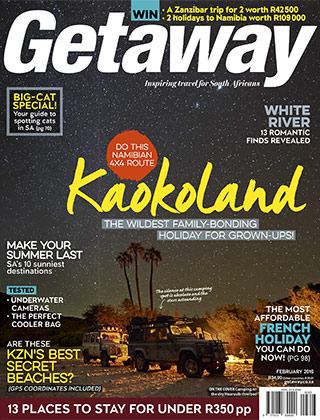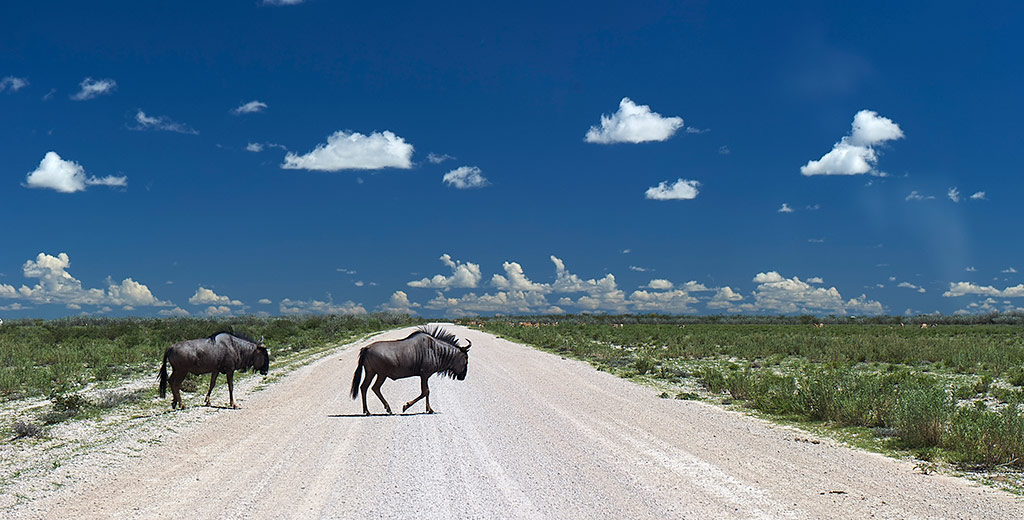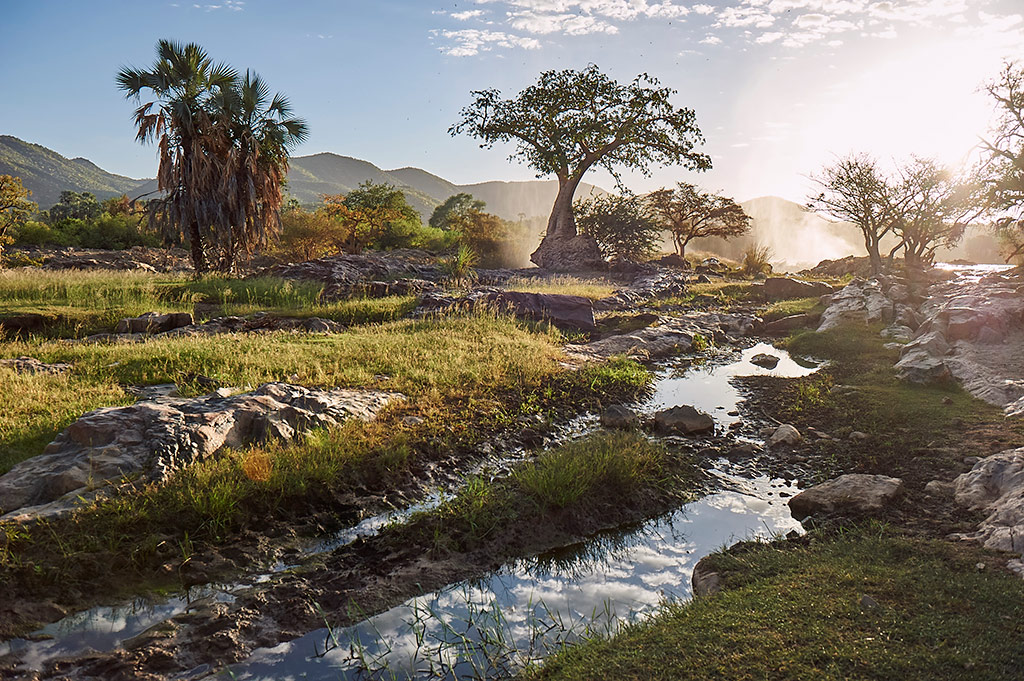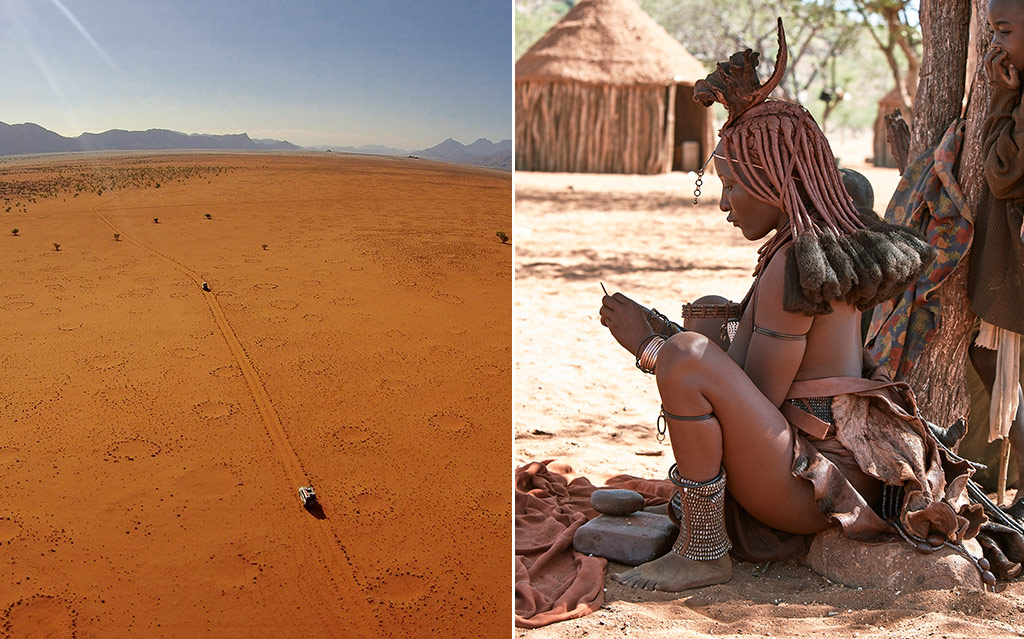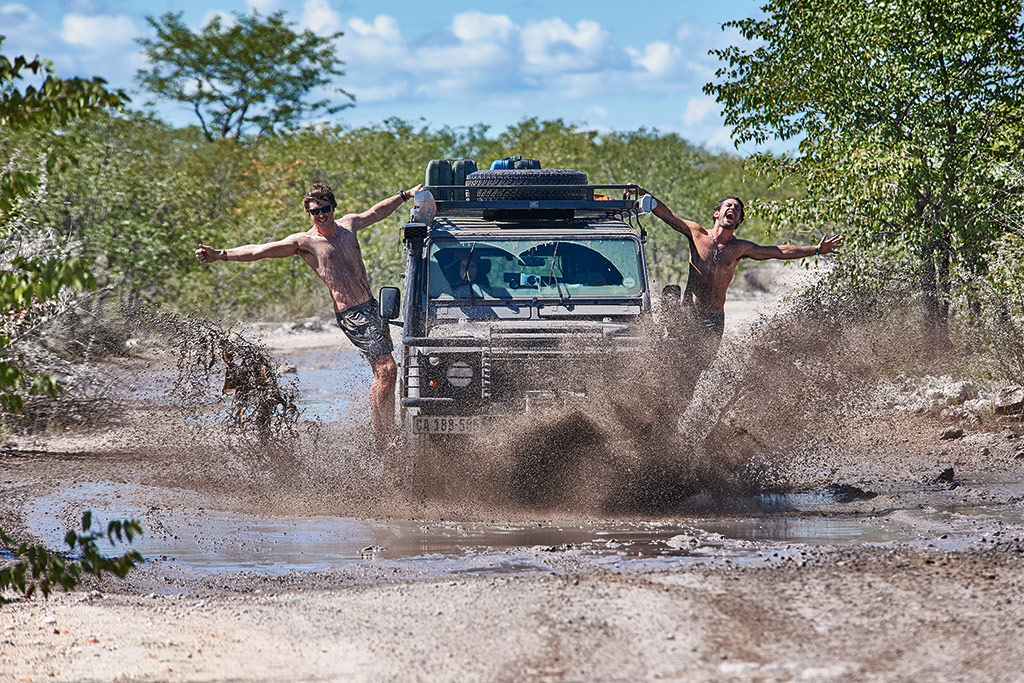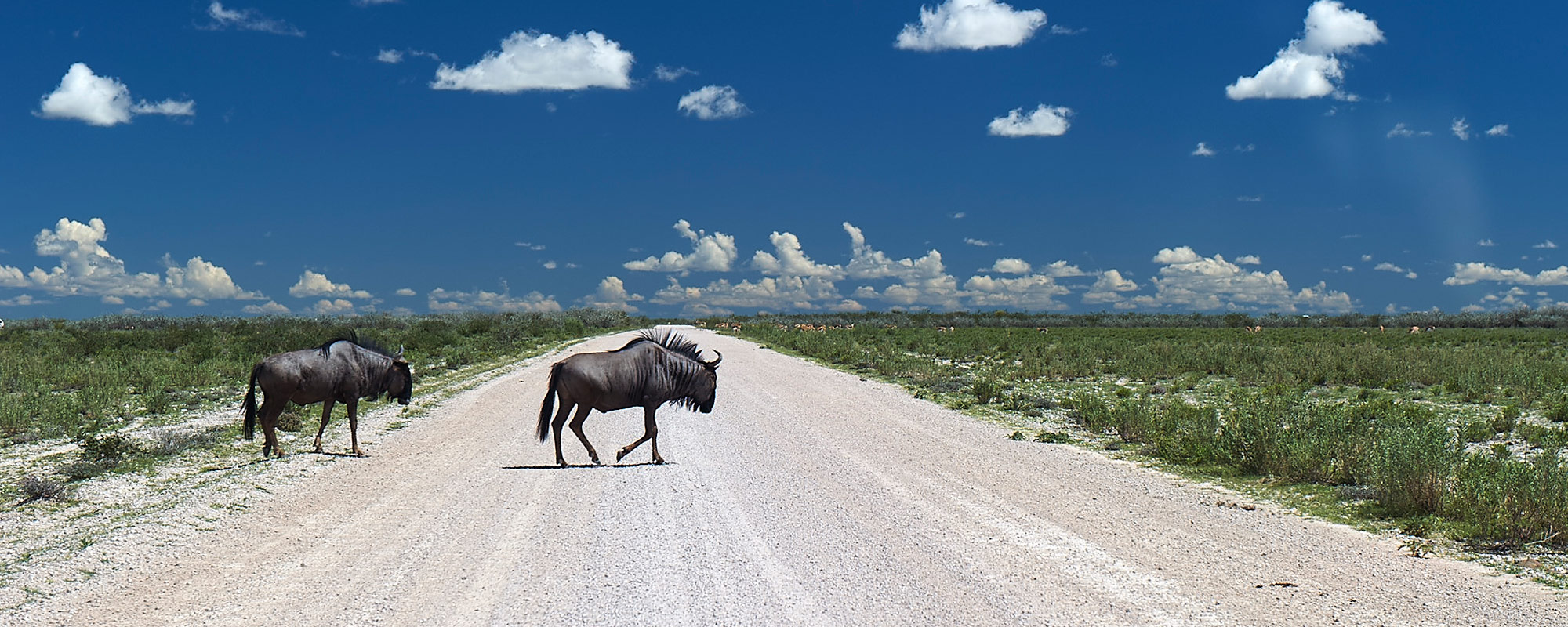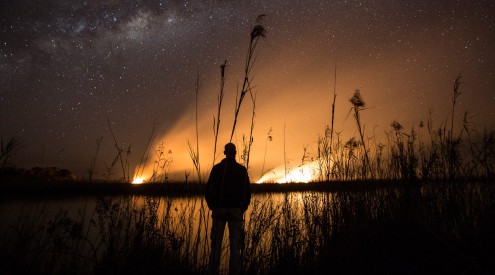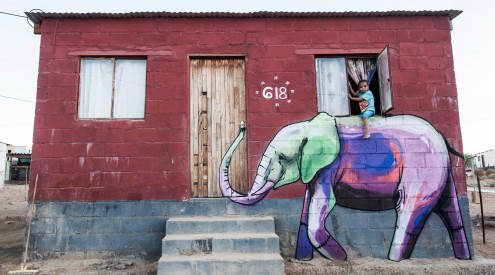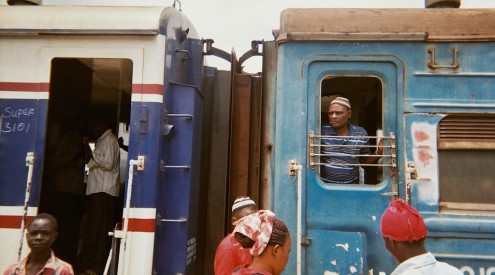It was one couple’s dream to drive from Cape Town to Kaokoland and take on Namibia’s legendary Van Zyl’s Pass. When their son graduated, they turned that dream into a (hair-raising) reality. Pictures by Robbert Koene, words by Gerda Genis.
Also read: How to book campsites in Namibia’s national parks
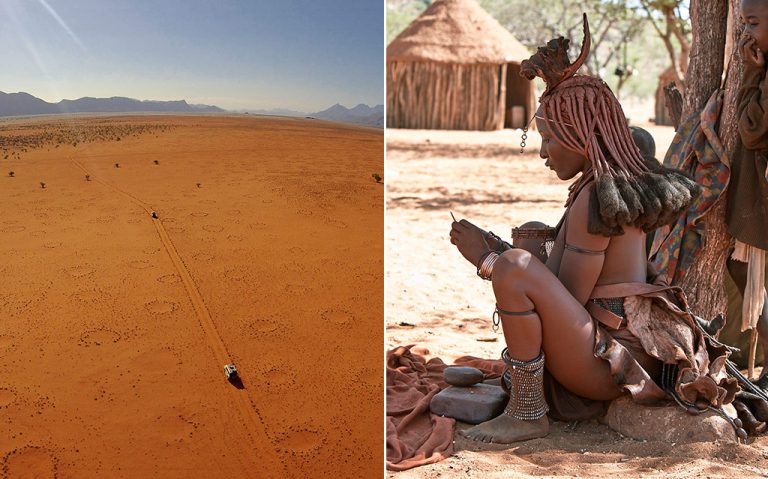
LEFT An aerial view of the Marienfluss shows the Landies driving through the fairy circles; RIGHT A Himba woman sharpens a tool.
Why it’s worth the trip
- With the Namibia dollar tied to the rand, travelling to this southwestern part of the continent remains relatively affordable for South Africans.
- Namibia is on every 4×4 enthusiast’s bucket list. The country is home to some of the best sand-dune driving in the world, incredible rocky passes and challenging dry riverbeds.
- Wild camping in Kaokoland is one of the most liberating travel experiences – it’s untouched, distances are generous and the silence complete.
‘Foxy Lady, come in for Thundercat! We suggest pulling off the road at the first opportunity.’
‘Copy that Thundercat, we’re right behind you.’
Two minutes later we grind to a halt in a muddy open area, just off the tar. It’s 7pm and pitch-dark. A rainstorm is pounding down, restricting our sight to about five metres. There’s no point driving, so we turn the volume louder until the sound of Hotel California drowns out the angry water smacking us from above. The radio crackles and distorted tones of Highway to Hell burst through. We look to our left and smile. Mike’s entire Land Rover, filled with three heads of bobbing hair, is bouncing to the rhythm like crazy. Carpe diem.
We’re somewhere between Keetmanshoop and Windhoek en route to Etosha. Then, as quickly as it had come, the rain stops and we move on. Driving in the dark is not recommended in Africa, let alone on wet roads. But we are running out of time, and have to squish what is essentially a three-week 4×4 trip to the northernmost part of Namibia into 15 days.
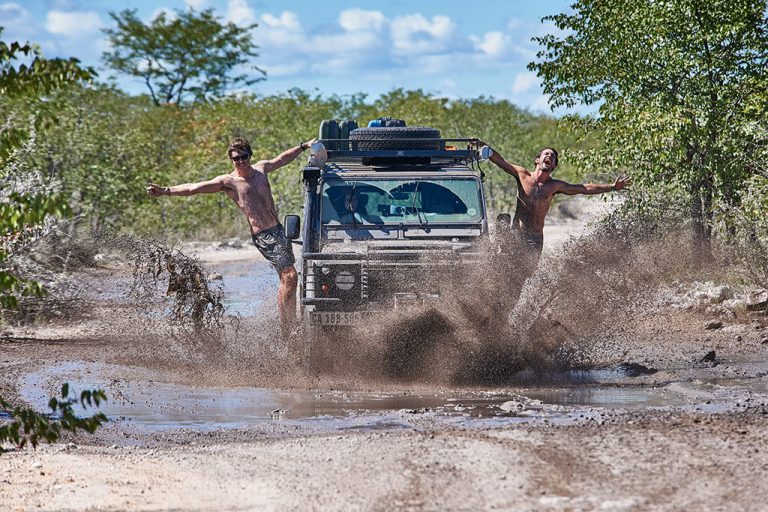
Mike and Benn cool down on the move.
This adventure has been a long-standing dream and when our son, Benn, completed his studies in Amsterdam, we jumped into action. His high school buddy, Mike, and girlfriend, Cieara, joined us and so, with two trusty Land Rover Defender Td5s, we set off from Cape Town for Namibia’s wild frontier, with the infamous Van Zyl’s Pass as the pinnacle of our adventure.
The first two days are a long haul. Apart from a border crossing at Noordoewer and stopping for photographs, it’s pretty much just driving. We snack, read, play music and keep pushing on. Finally we reach Okahanja, 70 kilometres north of Windhoek. We stock up for two days of camping in Etosha before spending the night in a chalet at King’s Highway rest camp.
The next morning we head for Okaukuejo Camp, 17 kilometres inside Anderson Gate, the southern entrance of Etosha National Park. Okaukuejo is the oldest and largest camp in the park and its main attraction is a permanent waterhole, which is floodlit at night. Beware: after sunset wily jackals sneak into the campsite and start waging war with dustbins and anything food-like. They will steal the meal off your plate if you leave it unattended for 30 seconds. The next morning, we discover one of Robbert’s sandals in a bush, the leather strap chewed to pieces!
Next we head north to the dust-bowl town of Opuwo, the last place to stock up on essentials before venturing into Kaokoland. There, we discover that the infinity pool at Opuwo Country Lodge’s campsite is the perfect place for an ice-laden gin and tonic overlooking the vast landscape. The following day, beleaguered by hordes of trinket sellers, we replenish our fridges with fresh consumables, top up with diesel and set out for Epupa, a 180-kilometre drive via the village of Okangwati.
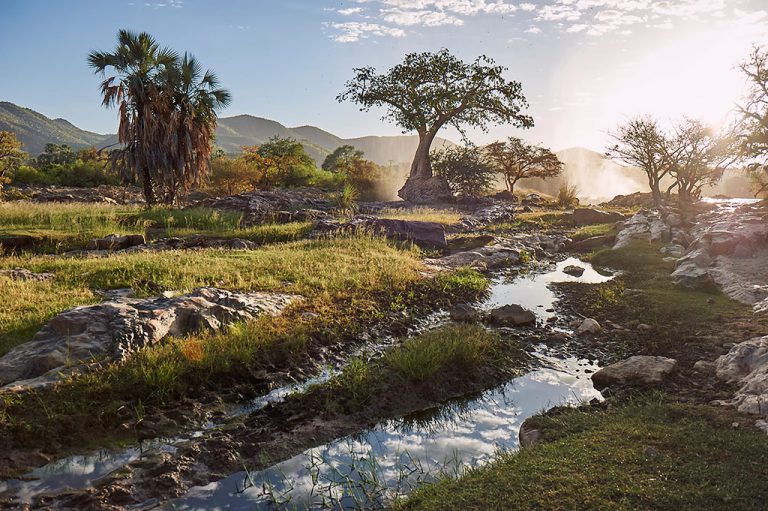
Early-morning mist drifts up from the thunderous Epupa Falls onto the plateau.
Unanimous cheers crackle across the radio as we arrive at Epupa Falls Lodge campsite. An oasis of shady palms stretches along the banks of the Kunene River in front of us, the mighty roar of the Epupa Falls less than 25 metres away. The river is the natural border between Namibia and Angola and this beautiful campsite, with friendly staff and a lookout-point bar, is the perfect spot to pitch camp for two days. We visit a Himba settlement and spend the rest of the time exploring the falls and wallowing in rock pools. But soon it’s time to face our nemesis: Van Zyl’s Pass.
We leave early to cover the arduous 116 kilometres to Van Zyl’s Pass campsite before sunset but are soon distracted by our surroundings. We stop to drink in the silence, cameras at the ready for anything from a flower to a lizard. We pull over and fly drones to photograph the magic, and before we know it night closes in on us… again! The road dwindles to a track and as darkness sets in, the track becomes a series of cracks and dongas through a narrow passage and up a ravine. Torches come on, cameras are forgotten, and we inch forward, walking the track ahead.
Bone-weary and saddle sore, we reach Van Zyl’s Pass campsite at 11pm. We huddle around the campfire until sleep finally claims our dusty bodies for an absolutely dreamless rest.
Breakfast, like all meals, is a serious activity in our family and soon we’re fuelled up, ready to tackle the pass. It’s everything we read about and more: a 12-kilometre series of hair-raising, knee-shaking descents along an exhilarating and ferociously challenging track, all amid incredible scenery.
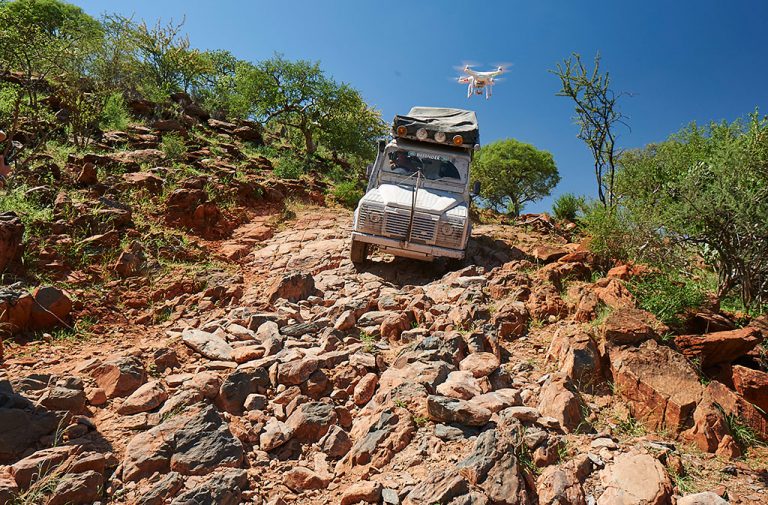
Our first tricky descent on Van Zyl’s Pass, under the watchful eye of our drone.
At the first big drop, I jump out of the car and the rest follow, cameras ready. We walk the track ahead, repack stones, discuss options over and over again. Robbert goes first, pearls of sweat popping on his brow as Mike guides him down via radio inch by inch, over cracks and boulders. The going is slow, and high fives and big cheers follow as each driver tests his skill and nerve.
At one point the path climbs up a hill and stops dead, and here we brew some coffee and take in the breathtaking view of the Marienfluss with its mysterious fairy circles. The long hours in the car, the heat, the dust, the messed-up tyres, quickly pale to insignificance.
Our aim is to get to Marble Camp, just before Orupembe. But once again, we’ve miscalculated and only reach our campsite around 10pm where warm showers welcome us. From Orupembe we make our way into the dry Khumib riverbed and follow the river south until it meets up with the Hoarusib River. Here our Tracks4Africa GPS software proves its worth because about half an hour before sunset, the bleep tracking our progress informs us that we are heading north. We had mistakenly turned into a tributary of the river and destroyed our chances of reaching Puros that evening. For the first time, we have to camp wild. We pitch our tents in soft sand under some palm trees, make a fire, photograph the incredible night sky and sleep in absolute soundlessness.
We continue south in the Hoarusib riverbed towards Puros the next day. The area is home to desert elephant, rhino and lion and we marvel at a couple of curious giraffe and their adaptability to the harsh desert environment. Then Thundercat announces accelerator problems via radio. We limp into Puros to find the one mechanic in town has gone to Sesfontein. We have no choice but to push on – covering the 100-kilometre stretch to Sesfontein along possibly the most badly corrugated road in Namibia.

Wildebeest saunter across the road in Etosha.
We let Thundercat go ahead, knowing we’ll catch up with Mike if he breaks down. It gives us time to stop often for photographs. This is a big mistake. The bad road conditions mean we have to pick our way around bushes and dunes, sometimes veering off track for more than a kilometre. On one such detour, Mike’s vehicle breaks down, and we miss them entirely. We have no radio contact (their battery ran flat), no way of knowing where they are.
We reach Sesfontein alone and stare at the setting sun. Thundercat doesn’t have a GPS, road map or radio. We’ve lost our whooping, head-banging youngsters in the middle of nowhere. The falling night feels cruel.
Six torturous hours later, Thundercat hobbles into town with a bottle of Captain Morgan and a big story. At our hotel, we sit well into the night as the three youngsters breathlessly regale us with their moments of despair: driving at 20 kilometres per hour and eating cold baked beans. After further tales of magnanimous locals, I am flooded with relief and gratitude.
The rest of our trip goes without incident (although we do end up towing Mike’s Defender 280 kilometres to Swakopmund). The youngsters start to look more and more like desert bandits, noses covered in bandanas and hair tousled with dust. Nobody is complaining, everybody is happy. And that Landy is still bouncing to the rhythm like crazy.
Need to know
We travelled for 15 days and covered about 6500km. It’s better done in three weeks with shorter daily distances. The total cost for this trip was about R50000 for five people (diesel R15000; lodging R15000; food and drink R20000).
It’s best to go during shoulder season. We travelled in the first two weeks of April when daytime temperatures are around 30°C and evenings around 20°C. In the summer months (November to April), it gets unbearably hot and in winter (June to September) it can be incredibly cold at night.
Keep in mind that off-road distances take a lot longer to cover. 4х4 experience is a must, especially on Van Zyl’s Pass and the riverbeds. Visas are not required by South Africans but you will need the following: a valid passport, driver’s licence, certified copy of vehicle registration papers in the driver’s name, and a letter of authority from the registered owner if the vehicle is not owned by the driver. If the vehicle is still being financed, carry a letter of authority from the bank (including travel dates) with the vehicle licence papers and a ZA sticker. Opuwo is the last diesel stop before Kaokoland.
What to do in Kaokoland
1. Visit a Himba tribe
Enquire about a guide at your campsite. Ours asked for R150 per person, as well as food for the tribe (another R100 per person). Ask permission before taking photographs.
2. Buy a Namibian SIM card
Pick one up at the border. It’s useful for booking campsites and great in case of emergencies. mtc.com.na
3. Visit the White Lady of Brandberg
It’s a famous rock painting in the Uis area. GPS: S21° 6.657’ E14°39.760’
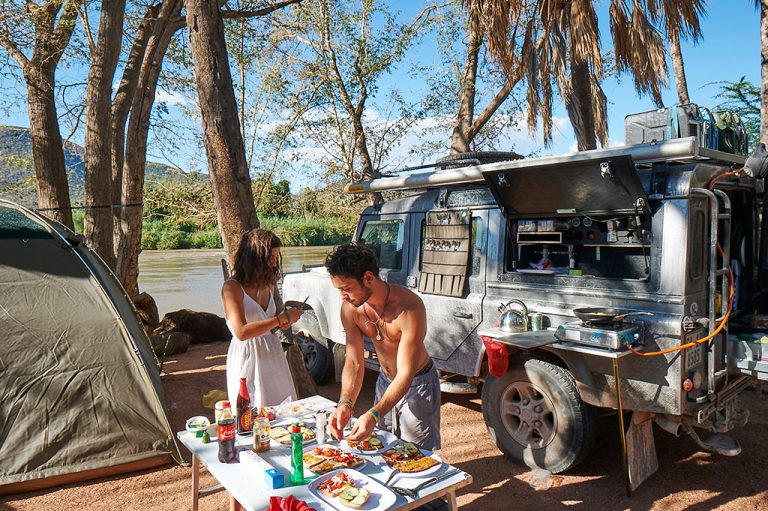
After days of eating dust, the Epupa Falls camp is bliss.
Where to stay in Kaokoland
1. River Chalets
River Chalets, Mariental, on the B1 road, has self-catering chalets from R600 for two sharing and camping from R100 per person.
2. King’s Highway Rest Camp
King’s Highway Rest Camp, near Okahandja, has comfy chalets from R510 for two sharing, and camping for R90 per person.
3. Okaukuejo Camp
Okaukuejo Camp, Etosha National Park, has electricity points, taps and a pool. From R136 per person and R220 per site (max eight people).
4. Opuwo Country Lodge
Opuwo Country Lodge, Opuwo, has an amazing rim-flow pool. There are 12 campsites, with water, electricity and a braai. From R160 per person.
5. Epupa Falls Lodge & Campsite
Epupa Falls Lodge & Campsite, Epupa, is a stone’s throw from Epupa Falls. All seven campsites have a braai. From R125 per person (maximum six people per site).
6. Van Zyl’s Pass Campsite
Van Zyl’s Pass Campsite, Otjihende, has three spacious sites next to a sandy riverbed, each with private ablutions. No booking is necessary. From R100 per person.
7. Marble Camp
Marble Camp, Orupembe, has large private sites with braai areas, hot showers and flushing toilets. No booking is necessary. From R100 per person.
8. Fort Sesfontein Lodge
Fort Sesfontein Lodge, Sesfontein, is over-priced, but a welcome break from the dust. From R1150 per person.
9. Palmwag Lodge & Campsite
Palmwag Lodge & Campsite, Palmwag, has 15 sites with braais and plug points, and is a good springboard to Damaraland. From R180 per person.
What to eat and drink
Most towns have general stores where you can get the basics. Buy bread from the local woman at Epupa. It’s delicious. She’ll find you at your campsite.
This article was first published in the February 2016 issue of Getaway magazine.
All prices correct at time of publication, but are subject to change at each establishment’s discretion. Please check with them before travelling.
